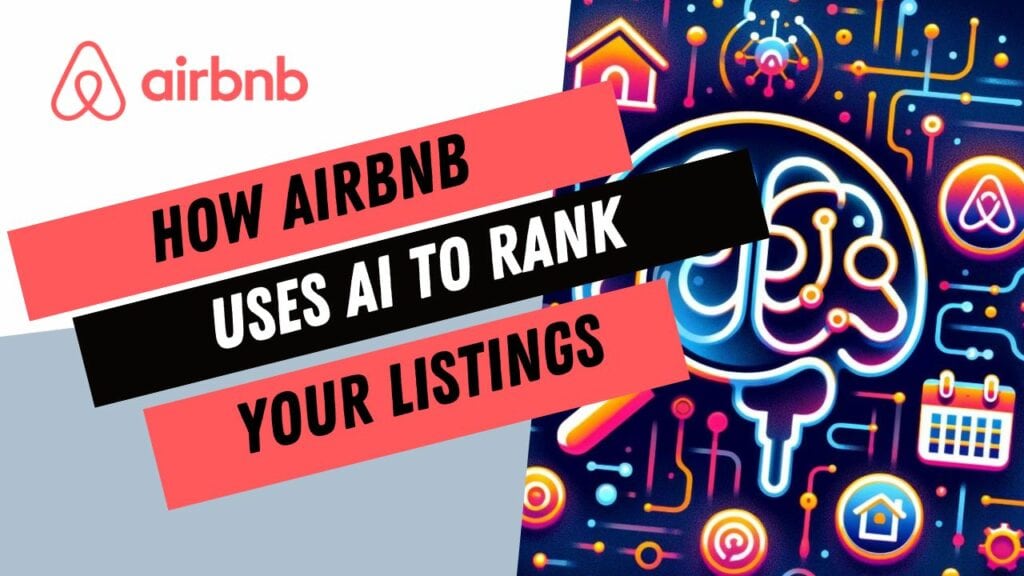As an Airbnb host, you’ve likely wondered how your listing ranks in search results on Airbnb. These questions might have crossed your mind:
- “On what basis does Airbnb rank listings?”,
- “Do all Airbnb searchers see the same rankings?”,
- “What happens when there’s not enough supply in an area?”
Moreover, you might have noticed how the search map on Airbnb automatically adjusts, zooming in or out, when you’re switching Airbnb Categories, for instance, from “cabins” to “amazing pools”. These observations lead to a bigger question: What’s really going on behind the scenes of Airbnb’s search functionality?
Airbnb is continually developing new technologies to enhance the guest search experience, increase bookings for hosts, and, ultimately, boost Airbnb’s bottom line.
We help you see how Airbnb is leveraging AI to tweak how your listings rank
At Rental Scale-Up, we’ve looked up for you recent tech papers produced by the Airbnb team. We’ve found examples of Airbnb leveraging AI (artificial intelligence) that we want to explain in accessible terms.
Airbnb has been busy buying AI-related companies, while its CEO Brian Chesky has discussed how Airbnb is leveraging AI in many parts of the business. For instance, he sees Airbnb using Generative AI to become “the ultimate travel agent”.
Two standout innovations are the Journey Ranker and the Low Inventory State (LIS), which are designed to personalize search results for each user, improving the match between guests and listings and increasing conversion rates.
The Journey Ranker fine-tunes how listings are presented to guests based on various factors, ensuring that each searcher sees results tailored to their preferences and behaviors.
On the other hand, LIS kicks in to optimize search outcomes when the availability in a particular area is low, adjusting the search parameters or even the map view to ensure guests can always find a place to stay.
The Secret Behind Your Airbnb Listing Rank: Understanding the Journey Ranker”
Hosts often wonder how Airbnb determines the ranking of their listings in search results, and the answer lies, among other things, within the intricate workings of the Journey Ranker.
This sophisticated system is at the core of Airbnb’s strategy to personalize search results, ensuring every guest sees listings tailored to their unique preferences and search behavior.
Your listing cannot be number 1 in Airbnb ranking as everyone sees something different
This personalization is critical to enhancing the likelihood of a match that leads to a booking, making the concept of a static “number one” ranking obsolete. In essence, the ranking of listings on Airbnb varies significantly from one user to another, depending on their individual interactions and preferences.
This personalized approach improves the experience for guests and increases the likelihood of bookings for hosts, making the entire Airbnb ecosystem more efficient and effective.
Here’s a closer look at how the Journey Ranker fine-tunes the process of matching guests with listings, ultimately aiming to improve conversion rates and create a dynamic, user-specific ranking system:
Understanding Guest Search Behavior:
The Journey Ranker acknowledges that guests often take their time searching, comparing different listings over weeks or even months. This means it’s crucial for a listing to stand out right from the start. By analyzing how guests interact with the platform from the beginning of their search, the Journey Ranker can adjust which listings are highlighted early in a guest’s exploratory phase.
Balancing Preferences:
This system doesn’t just throw random listings at guests. Instead, it looks at the actions guests take (like what listings they click on or request to book) and the specific details of their searches.
This method ensures that guests see listings that truly match what they’re looking for, and hosts get guests who are genuinely interested in their offering.
Guiding Towards Success:
The Journey Ranker pays attention to both positive actions (such as reservation requests) and negative actions (like cancellations). This attention to detail means it’s constantly adjusting to guide guests towards making a booking more smoothly, reducing obstacles along the way.
Adapting to Guest Behavior:
As guests narrow down their search, their behavior provides valuable insights. The Journey Ranker uses this information to refine search results, ensuring that listings are tailored to meet guests at the right point in their decision-making process.
Ensuring No Traveler Leaves Empty-Handed: The Magic of Airbnb’s LIS (Low Inventory State)
Finding the perfect Airbnb stay can sometimes feel like searching for a needle in a haystack, especially when specific demands or timing lead to surprisingly few options. Despite Airbnb’s extensive catalog of over 7 million listings, users can find themselves in a Low Inventory State (LIS), facing limited choices due to, for instance:
- Highly specific filters (e.g., beachfront, with a pool, pet-friendly, plus a helicopter pad),
- Late searches in peak seasons,
- Searches in remote or less-populated areas.
This scarcity is not just inconvenient for users; it’s a missed opportunity for Airbnb. Airbnb devised the LIS (Low Inventory State) mechanism to address this, acting as a smart detective to prevent users from hitting a dead end in their search.
How Airbnb’s LIS Keeps Your Search Full of Options
LIS first identifies potential low-supply scenarios by analyzing the user’s search criteria, timing, and desired location. This preemptive step is crucial in flagging when choices may become too narrow.
At Rental Scale-Up, we’ve observed several tactics to increase search results that this low inventory state could trigger in the Airbnb app and its website. While the document does not explicitly refer to these tactics, we think that these Flexible Matching options illustrate well how Airbnb can adapt when there is not much supply to show:
- Displaying Alternative Dates: When your preferred stay dates yield minimal options, Airbnb suggests other dates with better availability. It’s akin to finding that a sold-out concert has seats available on an alternate night, allowing you to enjoy the experience at a different time.
- Zooming Out the Map: If your search area is too restricted, Airbnb automatically broadens the geographical scope to unveil hidden gems nearby. This expansion is like widening your search for a nearby coffee shop on a map app, and discovering more options just a block away.
- Showing Listings That Partially Fit Criteria: When an abundance of filters leaves you no option, Airbnb relaxes the criteria slightly to introduce listings that closely match your preferences. This flexibility can lead to pleasant surprises, much like enjoying chocolate chip ice cream when your favorite chocolate flavor is sold out.
Airbnb’s Smart Tools: Helping Guests and Hosts Win (and increase Airbnb’s revenues)
The invention and implementation of technologies like the Journey Ranker and Low Inventory State (LIS) are crucial for Airbnb for several reasons, impacting the traveler search experience, host experience, and Airbnb’s bottom line:
Traveler Search Experience
- Personalization: The Journey Ranker ensures that travelers see listings that closely match their preferences and behavior, making the search process more efficient and satisfying. By presenting more relevant options, travelers can find what they’re looking for faster, leading to a better overall experience.
- Avoiding Overwhelm: Without intelligent ranking and inventory management, users could be overwhelmed by irrelevant listings or discouraged by too few options. Technologies like LIS prevent this by adjusting search parameters to ensure a healthy variety of choices, even in challenging search scenarios.
Host Experience
- Increased Visibility: Both Journey Ranker and LIS help increase visibility for hosts’ listings. By intelligently matching listings to the right travelers, hosts have a better chance of their properties being seen and booked by guests who are genuinely interested in what they offer.
- Optimized Occupancy: By suggesting alternative dates or expanding search areas, LSI helps to fill in booking gaps, especially during off-peak times or in less-searched areas. This leads to better occupancy rates and potentially higher earnings for hosts.
Airbnb’s Bottom Line
- Improved Conversion Rates: By making the search and booking process more personalized and efficient, these technologies help improve conversion rates. When travelers find what they’re looking for more easily, they’re more likely to book, which directly benefits Airbnb’s revenue.
- Enhanced User Retention: A positive user experience is key to retaining travelers and hosts on the platform. By continuously improving the search and booking process, Airbnb ensures that both guests and hosts remain engaged and satisfied, reducing churn and fostering loyalty.
- Data-Driven Insights: The data collected through the operation of Journey Ranker and LIS provides Airbnb with valuable insights into user behavior, preferences, and trends. This information can be used to further refine their algorithms, develop new features, and make strategic business decisions that drive growth.
Are the Journey Ranker and LIS examples of how Airbnb uses AI to help people find places to stay?
Yes, both the Journey Ranker and the Low Inventory State (LIS) are examples of Airbnb using AI (Artificial Intelligence) methodologies.
Here’s how they work in simpler terms:
- Journey Ranker uses what’s known as deep learning, a kind of AI that can process and learn from a lot of data. It looks at what guests do on Airbnb—like which listings they click on or ignore—and uses that info to figure out what each guest probably wants to see. It’s like if a website learned what movies you like based on what you’ve watched before and then suggested new movies that fit your taste.
- LIS (Low Inventory State) uses predictive modeling, another AI technique, to predict when there might not be enough listings available for what guests are searching for. It’s like if a weather app predicts rain based on current weather patterns and tells you to bring an umbrella. Airbnb’s version predicts when guests might not find enough places to stay and tries to help by offering suggestions, like looking at different dates or places.











